Don't wanna be here? Send us removal request.
Photo

Future SUSHI / 未来SUSHI
"Future SUSHI" is an installation that embodies the future of food, technology, and life sciences in a dystopian world through the lens of sushi, Japan's iconic dish. It spans the evolution of society from today to 100 years ahead, using a conveyor belt sushi restaurant setting to mirror scientific advancements and environmental challenges from 2020 to 2110. The moving sushi symbolizes the relentless march of time, with each piece representing future scenarios.


A robot waiter, cloned from the artist, shares stories of each sushi creation, blending narrative with dining. The artist crafted these futuristic dishes after detailed discussions with experts across various fields, integrating scientific facts with imaginative concepts. Highlights include "Muscle Snapper," created through genome editing to enhance protein content, and "Deep-Sea Fish Sushi," a concept born from future marine resource scarcity. Another notable creation is the "Rubble Mini Parfait," envisioning a time when humans have adapted to consume rubble due to extreme food shortages.

Exhibited at the Mori Art Museum, one of Japan's leading art institutions, "Future SUSHI" gained attention on social media, shared by young visitors and influencers. The installation engages viewers in contemplating the future of food and the environment, addressing issues like marine pollution, overfishing, and the looming threat of protein depletion. It presents a dystopian future realistically, prompting viewers to consider necessary actions in the present.
"Future SUSHI" not only explores technological innovations in food but also emphasizes the direct impact of these advancements on our health, lifestyle, and survival. Aimed at future generations, the work seeks to spark interest in food-related science, ethics, and environmental concerns, encouraging a positive approach to overcoming potential future challenges.
Interview
youtube
0 notes
Text
Work Details
Software
"Future SUSHI" includes two robots serving as the restaurant's managers, each engaging with guests.
The face of the artist, Etsuko Ichihara, was captured via 3D scanning and replicated in full-color resin to create masks for the robots. These masks, combined with motion programming that mimics Ichihara's movements, simulate a dystopian human clone using current technology.
The robots feature chest-mounted tablets that display menus mimicking the UI of Japanese sushi restaurants. They cyclically make and serve sushi while sequentially introducing every item on the menu. After presenting the last item, the robots experience a memory scramble, prompting them to restart the menu presentation from the beginning.
Another smaller robot is equipped with multilingual support to accommodate a global audience. This robot reacts to voice recognition from the audience to recommend sushi items and intentionally incorporates bug-like behaviors, such as sporadically revealing a different personality.
The robots utilized in the installation are humanoid robots from Softbank Robotics, specifically Pepper and Nao. The application development software used is Choregraphe.
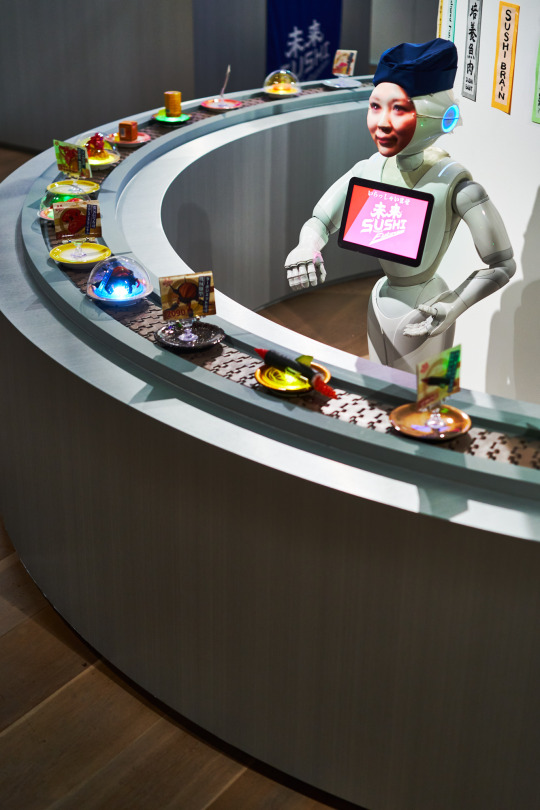
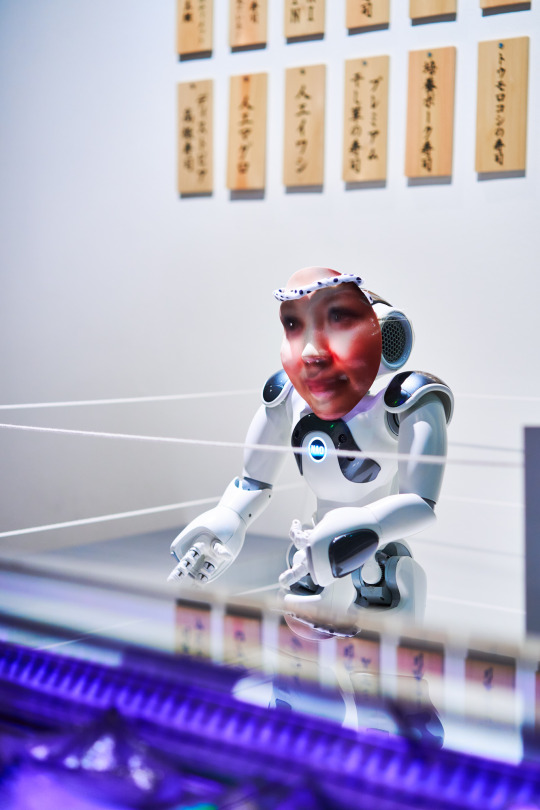
[From Curator's critique by Dr. Lena Fritsch, Ashmolean Museum, Oxford]
Ichihara's use of humanoids, which have also appeared in a number of her past works, mirrors Japan's interest in linking humans or animals with technological objects, often in a light-hearted manner.
I agree with technology researcher Sone Yuji, who has examined Ichihara's works through the lens of Japanese "techno-animism", arguing that there is a strong tradition of animism in Japan: it can be found in a "wide range of phenomena, beliefs, and practices, accounting for a wide range of spirits, gods, ancestors, ghosts, or malevolent monsters. Expanding on this idea of animism, a sense of social agency that blurs distinctions between organic beings and inanimate objects, and between humans and technological things, can also be assigned to the man-made-something that indeed appears to be deeply rooted in Japanese culture. Ichihara's art combining elements of Shintoism, Buddhism, and traditional culture with cutting edge technology represents a distinctively Japanese approach that cultural anthropologist Ann Alison has found in technological toy creations such as the Tamagotchi, defining it as the "animist unconscious".
Hardware
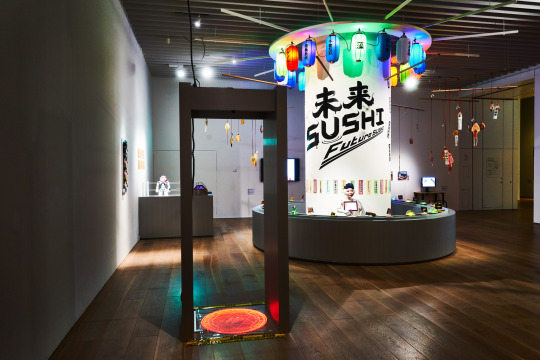
This installation comprises a combination of multiple devices:
[Food Samples]
The future sushi has been recreated using the traditional food sample technique from Japan's food industry. The artist interviewed scientists about future food trends and related scientific technologies, combining this evidence with their imagination to conceive and create future sushi under the policy of "half science, half fantasy." A total of 18 types of sushi were produced.
Here are examples of Future SUSHI.
- 2030 / Cultured Fish Meat SUSHI BABY - A sushi larva being cultured in a petri dish, very popular among citizens. Eating is prohibited since it is a companion sushi.

-2050 / Second Stomach Install Sushi - A sushi that assists gastrointestinal functions of mankind with a degenerated digestive organ.

-2070 / Deep Sea Fish Sushi - As a result of marine resources depletion, deep-sea fish are now served for human consumption. Not so sure about freshness and taste so deep-frying is recommended. Eating it raw is unsafe.
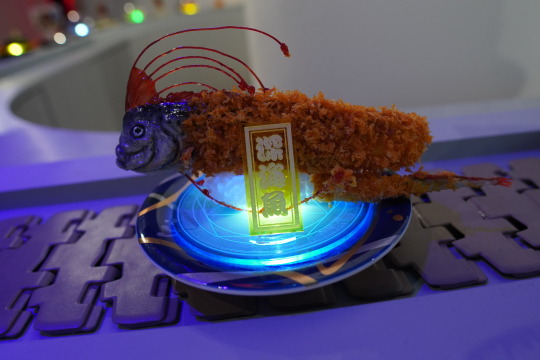
[Sushi Plate devices]
Illuminated sushi plates themed around "Future Sushi" were developed. Magical circles created by laser cutting shine with small LEDs, imagining the sushi appearing in the present day through a portal from the future society. Devices made by 3D printing are embedded in the underside of the plates, powered by Eneloop batteries, and can be switched on and off. The coloring is designed to match the form of each sushi.
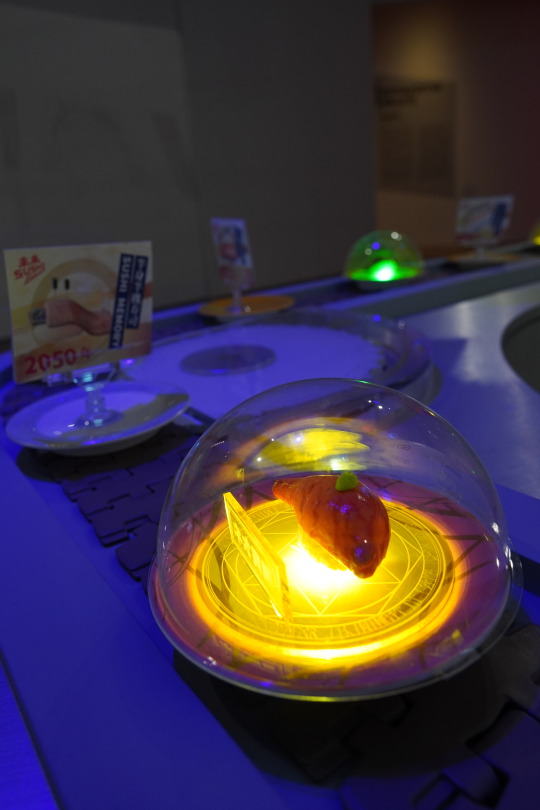
[Sushi conveyor]
The sushi conveyor, symbolizing the representation of automation and the relentless flow of time prior to the COVID-19 pandemic, was chosen for its relevance. Using real conveyor chains for sushi ensures stable operation.
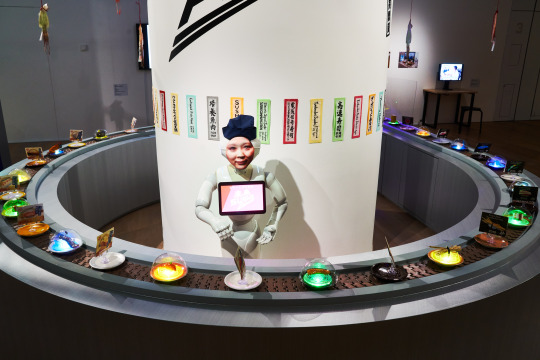
[Magical dystopian security gate] As a boundary marker of the dystopian worldview, a security gate stands at the entrance to Future SUSHI. When humans pass through, it detects "future contraband," causing magical circles to light up randomly. Implemented with Arduino, infrared sensors, and Neopixel, it reacts to human passage through the gate. Only children are exempt from the contraband detection (with an exclusion setting for children's height).



[Other objects of the installation] -Mysterious Sushi Showcase: A showcase that contains replicas of such futuristic ingredients as brains, cultured salmon roe, artificial wasabi, and natural fish aged for 70 years.
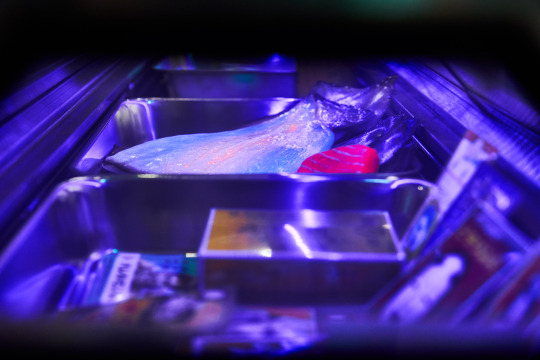
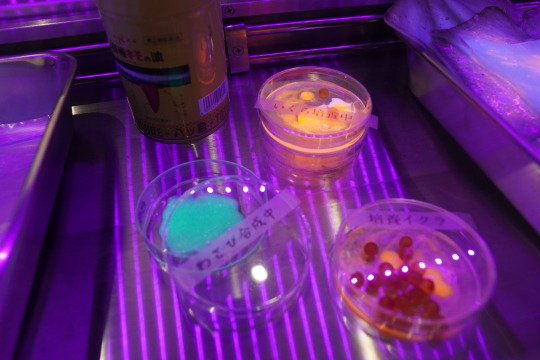
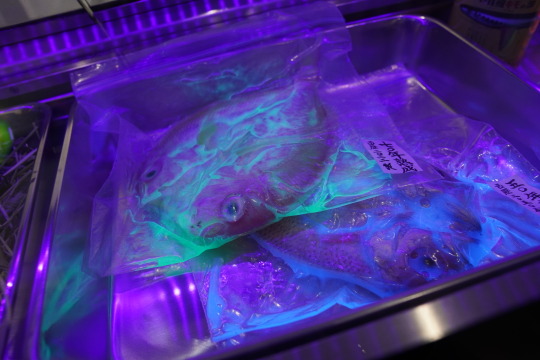
-Future SUSHI Price List: A list of future SUSHI prices. The currency is NY (Neo YEN), and prices are estimated to be 100 times the current prices due to inflation. With the note: "Survival tax and oxygen charges are not included.”
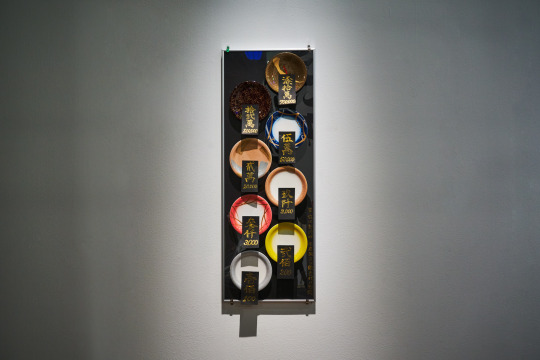
Technical Requirements
[Equipment provided by the artist]
Essentials: - 18 food samples of futuristic sushi - 18 rotating sushi plates - Eneloop batteries (AAA) x20 and a charger
Items to send according to exhibition requirements: - Humanoid robot / Softbank Nao (for overseas exhibitions, a smaller robot will mainly be used) - Robot face masks - Rotating conveyor (for overseas shipping, a lighter and simplified mechanism will be considered; for a previous exhibition in Graz, Austria, a full-scale product conveyor was sourced locally, so using the same fixture might be possible) - LED mechanism for magical circle gate, circular acrylic, Arduino - Other decorative items and equipment can be provided as needed - Note: For a minimum package excluding the robot, shipping costs from Japan to Austria are approximately 450€ (based on previous exhibition experience in Graz). Items can be customized according to budget and exhibition content
[Equipments by Ars Electronica]
- 1 monitor - 1 PC for robot control - 1 display fixture for the robot - Fixture simulating an airport gate - Power supply
[Space requirements]
- A space of 5m x 5m is desirable, ideally with at least one wall - A dimly lit space is preferable for LED visibility
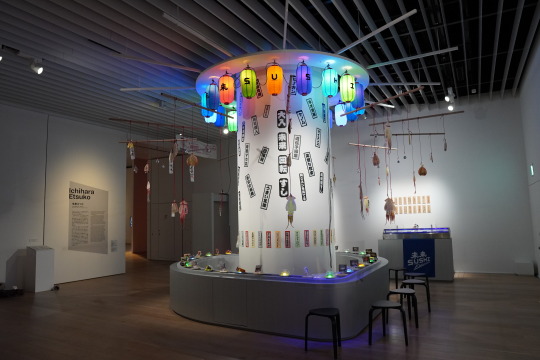
[Required persons and support]
- Having staff familiar with the robot control app (Choregraphe) is desirable; the operation is straightforward and can be performed by anyone - Daily battery replacement for sushi plates is necessary
[Notes]
- The design and content of the exhibition can be flexibly adjusted according to budget and space requirements
0 notes
Text
Artist / Credit

Etsuko Ichihara
Artist, Fantasy inventor, Digital Shamanist
Etsuko Ichihara is Japanese artist. Born 1988 in Aichi. Graduated in Studies of Media, Body and Image from the School of Culture, Media and Society, Waseda University. She has been creating artworks that interpret Japanese culture, customs and beliefs from a unique point of view, and present new, technology-based approaches. Thanks to their strong impact, these works have been introduced across a wide range of media all over the world, such as newspapers and TV programs, radio programs, and magazines. Ichihara’s works were included in the Excellence Award at the 20th Japan Media Arts Festival, Entertainment Division in 2017, and in 2016, chosen for the INNOvation program from The Ministry of Internal Affairs and Communications. She won Honorary Mention (Interactive Art+) in PRIX Ars Electronica 2018 and received a STARTS Prize Nomination in the same year recently. She has recently presented her works in exhibitions such as ‘Digital Shamanism: Japanese Funeral and Festivity’ at NTT InterCommunication Center [ICC], ‘Cyber Arts Exhibition 2018’ at Ars Electronica Festival in Linz, Japan Media Arts Festival, ‘Mediating Asia’ at National Taiwan Museum of Fine Arts, ‘Roppongi Crossing 2022’ at the Mori Art Museum.

Interview at toco toco TV
youtube
TEDxUTokyo(Japanese)
youtube
Credits
Conveyor mechanical design and development: Hayashi Tamio (TASKO Inc.) Technical direction: Okiyama Ryota (TASKO Inc.), Kimura Masataka (TASKO Inc.) Sushi plate device development and installation: Nakaji Hiroaki Food sample modeling cooperation: Sato Sample, IWASAKI CO., LTD. Robot application development: Watanabe Chika Scenography cooperation: Sammonji Masaya (BKY+SENTO-DASHI committee), Uchiumi Kohei (BKY+SENTO-DASHI committee) Logo design: Hata Yurie Translation: Sato Ayako Cast: Fujii Naotaka, Mishima Yuta, Hokamura Hitoshi Video Supervision: Sakamoto Asato
Support received from
Production cooperation: Digital Hollywood University, 100BANCH, Poled Co., Ltd, ZENTech, Inc., Nofty, Inc., Kazuo Wakamiya Technical cooperation: TASKO Inc., RYUDOSHOTEN L.L.C., yakushoku saffrondo, BnA Co.,Ltd Cooperation: Mori Art Museum
0 notes